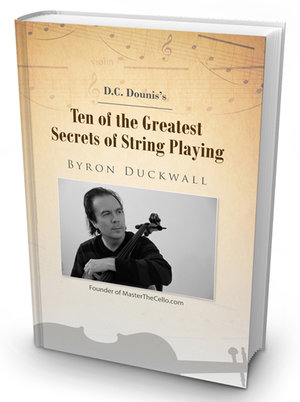D.C. Dounis described several key points about performing the Bach cello suites or solo violin partitas. To understand his ideas let's us look at the following observations...
Continue ReadingA Cure for Cold Hands from SPCO Principal Cellist Joshua Koestenbaum
/The wonderful cellist of 30+ years with the Saint Paul Chamber Orchestra, Joshua Koestenbaum reveals a trick he learned from a bio feedback expert while at Yale University...
Continue ReadingSecrets of the Vibrato Part 2
/“The Sizzle”
Dounis referred to the impulse which starts the vibrato as the “sizzle.” He gave the example of touching a hot surface, like a frying pan. He also said “the sizzle” was the spark plug that ignited the vibrato. This is a single impulse similar to a guitarist who plucks his string in to emulate a legato. He must give the impulse enough force or pluck it hard enough to carry the sound to the next note. The vibrato is the same. The initial “shake” has to be enough to carry it through the note.
Therefore, if a player learns how to isolate this initial shake, then he or she can begin to understand how the vibrato and the left hand technique works altogether...
Continue ReadingSecrets of the Vibrato part 1
/For years, the vibrato has long been thought of primarily as a means of adding expression to melodic passages. An “add on.” Teachers have emphasized this point which has resulted in a primary misconception.
Vibrato is more than a way to add expression to particular notes.
Vibrato is the basis of left hand technique...
Continue ReadingD. C. Dounis Interview
/The following interview was published in the book "With The Artists" in 1955. To my knowledge it is the only documented interview with Dounis ever made and probably occurred in the early 1950s in New York City.
Continue ReadingDisplaced Impulses...A Common Problem That is Relatively Unknown
/What are "Displaced Impulses?"
These are impulses that end up in the wrong part of body when a player is struggling with a passage technically and work contrary to the natural movements of the body. A classic example is someone bobbing their head when playing a difficult passage. Of course it can be any part of the body, but always prevents the natural motion needed to play a passage.
The Cure...
Continue ReadingDounis - "Always play 1/2 an inch above the string!"
/Dounis always told his students to always imagine they were playing on a string 1/2 an inch above the real string.
To understand what he meant, do this exercise...
Continue ReadingDounis - "Up Bow and Down Bow are Different Bowing Techniques"
/Dounis said that most string players "don't realize that the technique of Up Bow is very different than the Down Bow."
So... What's the difference?
Here's a breakdown...
Continue Reading
How to play Bach Cello Suites - Symbols and Numerology
/It is debatable whether knowing about Bach's use of numbers and musical affections teaches us better how to play Bach cello suites, but it can't hurt. Bach is known to have used Numerology and the Doctrine of Affectations as a way to personalize his music and express his devotion to God.
Continue ReadingRare performance of Bloch's Schelomo by George Neikrug
/New video on Youtube - Part 1 of Ernst Bloch's Schelomo with George Neikrug on cello.
Continue ReadingMaster of the Ricochet - Alexander Markov
/Many violin virtuosos perform the 5th Paganini Caprice, but rarely do you see them play the original ricochet bowings. Alexander Markov not only plays this Caprice but dazzles one with his effortless mastery of these seemingly impossible bowings.
Continue ReadingA rarely observed fact that can instantly change your bow arm!
/I was working with an exceptional violinist the other day and discovered that she didn't know this important but little known fact of the bow. This is how the conversation went. I said to her...
What is the line or direction of the pull on the down bow?
Quickly we deduced that it is to the right and horizontal.
Then I asked her what is the direction of pressure?
After considering it for a moment it was discovered to be vertical or downward. Then we proceeded to the up bow.
Continue Reading

















